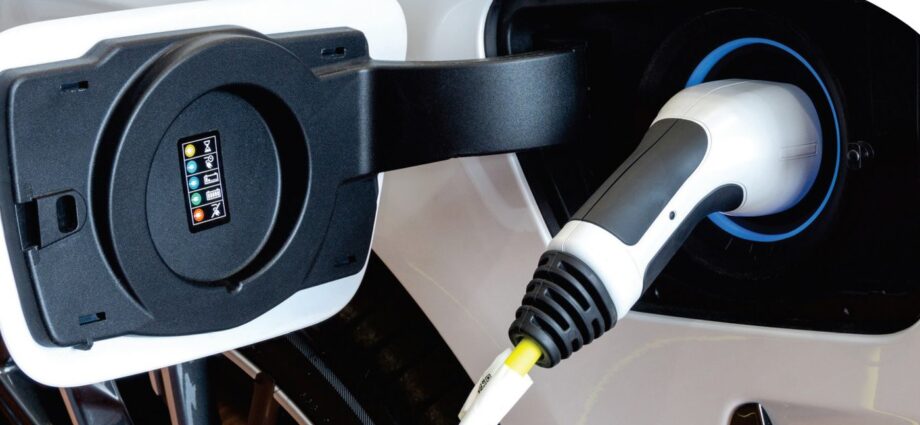
By Patrick Penner, Local Journalism Initiative Reporter, Tri-Cities Dispatch
May 28, 2024
Port Moody is planning to rapidly expand its electric vehicle (EV) infrastructure over the next six years.
The Tri-Cities Zero Emission Mobility Plan was unanimously endorsed by council on May 21, aiming to nearly quadruple the number of charging stations around the city by 2030, for an estimated cost of nearly $1.7 million.
“Our mobility ecosystem is changing, and changing fairly rapidly,” said Jeremy Finkleman, a WSP consultant hired by the city. “The share and pure number of EVs on Port Moody streets will be drastically increasing in the near term.”
Federal and provincial mandates banning the sale of internal-combustion-engine vehicles by 2035 is expected to spike the number of registered EVs in Port Moody from around 700 in 2021, to between 3,400 and 8,600 by 2030, according to WSP modelling.
As “shortfalls” exist in Port Moody’s current charging infrastructure, notably in public areas, a significant expansion is needed to accommodate the expected EV influx, according to the report.
The city needs to grow the number of charging stations from 32 level-two EV chargers and one DC fast charger today, to approximately 130 level-two chargers and 11 fast chargers by 2030, the report stated.
Installation costs for the two charging station types would come with a price tag of $800,000 and $860,000, respectively.
Port Moody is not alone. Across the Tri-Cities, 850 to 2,220 level-two public chargers will be needed by 2030, along with 75 to 200 DC fast chargers, according to the report’s projections.
“The reality is to move to a more sustainable future, we need to do more than just shift how people are traveling,” Finkleman said. “We need to change the way vehicles are propelled, we need to change the fuel in vehicles.”
Transportation emissions account for around half of Port Moody’s total emissions, and its 2020 Climate Action Plan has set a goal achieving carbon carbon neutrality by 2050.
Currently, 83 percent of all daily trips in Port Moody are taken by automobile, with approximately 1.4 vehicles per household.
While the CAP goal is to have 40 percent of all passenger vehicles and 25 percent of all commercial vehicles be electric by 2030, Finkleman said he did not think the target is achievable.
The most recent data (2021) shows that 13.7% of Port Moody’s new vehicle sales were EVs, while only 3.5 percent of its total vehicles are EVs.
“That 40 percent doesn’t strike me as being realistic,” Finkleman said, adding a 20 percent figure for light-duty EVs was supported.
Upgrading local charging infrastructure “signals a pivotal commitment” by the city, according to the report.
Its strategy has two main areas of focus: installing public charging stations throughout the Tri-Cities; retrofitting multi-unit residential buildings and ensuring new builds are 100 percent EV ready.
Public priority charging locations have also been identified, recommending areas with high population and employment density across a mix of land use types.

Multi-family residential buildings make up 35 percent of Port Moody’s housing stock, and the report stresses the need to ensure residents have access to chargers through bylaw changes, retrofit support and legislation.
It underscores the importance of advocating for the province’s right-to-charge legislation – which would prevent stratas from prohibiting residents from installing EV chargers in their parking spots.
While EV upgrades will come at a significant cost to the city, the vast majority of the upgrade costs will be borne by building owners and occupants, according to the report.
It calculates that if 25 percent of Port Moody’s 32,000 multi-family residential units are retrofitted with one charger per parking stall by 2030, the cost will range from $30 to $114 million. There is opportunity to leverage the province’s low-carbon fuel credits to support the needed expansion, the report stated.
Coun. Diana Dilworth said the province subsidized charging stations in her residential building, covering two-thirds of the cost for owners. She added that while supports the right-to-charge legislation, EV upgrades should not come at the expense of municipalities or taxpayers.
“I think there’s a great role for private builders,” Dilworth said. “I wonder if, as a council at some point, we might be able to talk about mandating the number of EV chargers in (new transit-oriented development areas).”
Collaboration between municipalities, regional entities, and private businesses will be needed to help plug the EV infrastructure gap and share the financial burden, according to the report.
For instance, Finkleman suggested Tri-Cities’ governments share the staffing costs related to the zero emission mobility plan; or that public or commercially owned land be offered up for station locations, such as municipal parking lots, grocery stores, gas stations, and mall parking lots.
Another aspect of the plan is supporting and promoting the use of E-micro mobility options, such as electric scooters and bikes.
While Coun. Callan Morrison supported the 10-year timeline, he raised concerns about the dominant investment into EV infrastructure as cleaner options may exist by 2050.
He pointed out that Toyota Prius kickstarted the hybrid vehicle era just 25 years ago, but Telsa battery-powered EVs caused a dramatic market shift in 2006.
“Now everybody’s talking about battery vehicles, and that’s a matter of six or seven years,” Morrison said. “I just don’t want us to go down a path that puts us too much invested into one technology path.”
Morrison added the extraction practices related to EV batteries are “ridiculously harsh on the environment,” and he expects the market trends to change again over the next decade.
Finkleman said the plan was deliberately focused on electric-mobility options, and the near term actions required to accommodate the number of new EVs. He said a longer-timeframe approach may be warranted to explore other technology types.
Subscribe to our newsletter.
“You’re absolutely right,” Finkleman said. “Going forward, certainly to 2050, there are a vast array of different types of zero-emissions mobility (options).”

